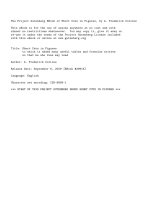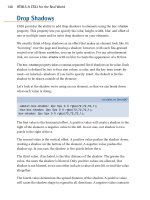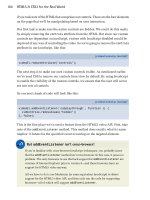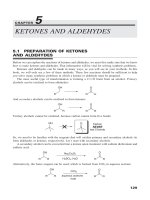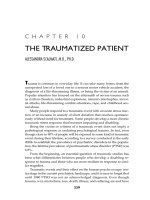Ebook The psychiatric interview in clinical practice (3/E): Part 1
Bạn đang xem bản rút gọn của tài liệu. Xem và tải ngay bản đầy đủ của tài liệu tại đây (9.43 MB, 355 trang )
THE PSYCHIATRIC
INTERVIEW IN
CLINICAL PRACTICE
T H I R D
E D I T I O N
This page intentionally left blank
THE PSYCHIATRIC
INTERVIEW IN
CLINICAL PRACTICE
T H I R D
E D I T I O N
ROGER A. MACKINNON, M.D.
Professor Emeritus of Clinical Psychiatry
College of Physicians and Surgeons of Columbia University
New York, New York
ROBERT MICHELS, M.D.
Walsh McDermott University Professor of Medicine and Psychiatry
Weill Medical College of Cornell University
New York, New York
PETER J. BUCKLEY, M.D.
Professor of Psychiatry and Behavioral Sciences
Albert Einstein College of Medicine of Yeshiva University
Bronx, New York
Note: The authors have worked to ensure that all information in this book is
accurate at the time of publication and consistent with general psychiatric and
medical standards, and that information concerning drug dosages, schedules,
and routes of administration is accurate at the time of publication and consistent with standards set by the U.S. Food and Drug Administration and the general medical community. As medical research and practice continue to advance,
however, therapeutic standards may change. Moreover, specific situations may
require a specific therapeutic response not included in this book. For these reasons and because human and mechanical errors sometimes occur, we recommend that readers follow the advice of physicians directly involved in their care
or the care of a member of their family.
Books published by American Psychiatric Association Publishing represent the
views and opinions of the individual authors and do not necessarily represent
the policies and opinions of American Psychiatric Association Publishing or the
American Psychiatric Association.
If you wish to buy 50 or more copies of the same title, please go to www.appi.org/
specialdiscounts for more information.
Copyright © 2016 American Psychiatric Association
ALL RIGHTS RESERVED
Manufactured in the United States of America on acid-free paper
19 18 17 16 15
5 4 3 2 1
Third Edition
Typeset in Palatino and GillSans
American Psychiatric Association Publishing
1000 Wilson Boulevard
Arlington, VA 22209-3901
www.appi.org
Library of Congress Cataloging-in-Publication Data
MacKinnon, Roger A., author.
The psychiatric interview in clinical practice / Roger A. Mackinnon, Robert
Michels, Peter J. Buckley ; with contributions by John W. Barnhill, Brad Foote,
Alessandra Scalmati. — Third edition.
p. ; cm.
Includes bibliographical references and index.
ISBN 978-1-61537-034-4 (hardcover : alk. paper)
I. Michels, Robert, author. II. Buckley, Peter, author. III. Title.
[DNLM: 1. Interview, Psychological—methods. 2. Mental Disorders—diagnosis. 3. Physician-Patient Relations. 4. Psychotherapy—methods. WM 143]
RC480.7
616.8914–dc23
2015029338
British Library Cataloguing in Publication Data
A CIP record is available from the British Library.
This book is dedicated to Cynthia, Verena, and Maxine.
This page intentionally left blank
CONTENTS
About the Authors . . . . . . . . . . . . . . . . . . . . . . . . . . . .ix
Preface . . . . . . . . . . . . . . . . . . . . . . . . . . . . . . . . . . .xi
Acknowledgments . . . . . . . . . . . . . . . . . . . . . . . . . . . . xv
P A R T
I
General Principles
1
General Principles of the Interview . . . . . . . . . . . . . . . . . . . 3
2
General Principles of Psychodynamics. . . . . . . . . . . . . . . . . 77
P A R T
I I
Major Clinical Syndromes
3
The Obsessive-Compulsive Patient . . . . . . . . . . . . . . . . . . 105
4
The Histrionic Patient. . . . . . . . . . . . . . . . . . . . . . . . . 133
5
The Narcissistic Patient . . . . . . . . . . . . . . . . . . . . . . . . 173
6
The Masochistic Patient. . . . . . . . . . . . . . . . . . . . . . . . 201
7
The Depressed Patient . . . . . . . . . . . . . . . . . . . . . . . . 225
8
The Anxiety Disorder Patient . . . . . . . . . . . . . . . . . . . . 277
9
The Borderline Patient . . . . . . . . . . . . . . . . . . . . . . . . 311
10
The Traumatized Patient . . . . . . . . . . . . . . . . . . . . . . . 339
Alessandra Scalmati, M.D., Ph.D.
11
The Dissociative Identity Disorder Patient . . . . . . . . . . . . . .373
Brad Foote, M.D.
12
The Antisocial Patient . . . . . . . . . . . . . . . . . . . . . . . . .405
13
The Paranoid Patient. . . . . . . . . . . . . . . . . . . . . . . . . .437
14
The Psychotic Patient . . . . . . . . . . . . . . . . . . . . . . . . .473
15
The Psychosomatic Patient. . . . . . . . . . . . . . . . . . . . . . .499
John W. Barnhill, M.D.
16
The Cognitively Impaired Patient . . . . . . . . . . . . . . . . . . .513
John W. Barnhill, M.D.
P A R T
I I I
Special Clinical Situations
17
The Emergency Patient. . . . . . . . . . . . . . . . . . . . . . . . .533
18
The Hospitalized Patient . . . . . . . . . . . . . . . . . . . . . . . .557
John W. Barnhill, M.D.
19
The Patient of Different Background . . . . . . . . . . . . . . . . .573
P A R T
I V
Technical Factors Affecting the Interview
20
Note Taking and the Psychiatric Interview. . . . . . . . . . . . . .603
21
Telephones, E-Mail, Other Digital Media,
and the Psychiatric Interview . . . . . . . . . . . . . . . . . . . . .611
Afterword . . . . . . . . . . . . . . . . . . . . . . . . . . . . . . . .635
Bibliography . . . . . . . . . . . . . . . . . . . . . . . . . . . . . . .637
Index . . . . . . . . . . . . . . . . . . . . . . . . . . . . . . . . . . .657
ABOUT THE AUTHORS
Roger A. MacKinnon, M.D., is Professor Emeritus of Clinical Psychiatry in the College of Physicians and Surgeons of Columbia University,
and Training and Supervising Analyst at the Columbia University Center for Psychoanalytic Training and Research, in New York, New York.
Robert Michels, M.D., is Walsh McDermott University Professor of
Medicine and Psychiatry at Weill Medical College of Cornell University,
and Training and Supervising Analyst at the Columbia University Center for Psychoanalytic Training and Research, in New York, New York.
Peter J. Buckley, M.D., is Professor of Psychiatry and Behavioral Sciences at Albert Einstein College of Medicine of Yeshiva University in
Bronx, New York; and Training and Supervising Analyst at the Columbia University Center for Psychoanalytic Training and Research in New
York, New York.
Contributors
John W. Barnhill, M.D., is Professor of Clinical Psychiatry, DeWitt Wallace Senior Scholar, and Vice Chair for Psychosomatic Medicine in the
Department of Psychiatry at Weill Medical College of Cornell University;
and Chief of the Consultation-Liaison Service at New York-Presbyterian
Hospital/Weill Cornell Medical Center Hospital for Special Surgery in
New York, New York.
Brad Foote, M.D., is Associate Professor of Clinical Psychiatry and Behavioral Sciences at Albert Einstein College of Medicine/Montefiore
Medical Center in Bronx, New York.
Alessandra Scalmati, M.D., Ph.D., is Associate Professor of Clinical
Psychiatry and Behavioral Sciences at Albert Einstein College of Medicine/Montefiore Medical Center in Bronx, New York.
The authors and contributors have no competing interests to report.
ix
This page intentionally left blank
PREFACE
T
he third edition of this book builds on the second, which was published
in 2006. Unlike the second edition, written 35 years after the first, the
changes in psychiatry, in the intervening 9 years, have been less enormous
or revolutionary. In an editorial in the American Journal of Psychiatry in
2006, we delineated and critiqued the radical developments that had occurred in the psychiatric landscape between the publication of the first
and second editions. These included the refinement of phenomenological
psychiatric diagnosis in DSM-III and subsequent revisions, an increasing
biological knowledge base for understanding the somatic origins of mental illness and effective pharmacological treatments, the expansion of
psychodynamic thinking beyond ego psychology to incorporate differing
theoretical perspectives, and a dramatic shift in sociocultural attitudes toward the clinician-patient relationship. The last-mentioned development
remains especially relevant and continues to inform the psychiatric interview. The social relationship between patient and clinician is no longer
asymmetric. Patients are now better informed, correctly believe that their
bodies and minds belong to them, and wish to be involved in treatment
decisions. The therapeutic alliance between doctor and patient has become the foundation of treatment efforts in all of medicine. The assertion
of the intrinsic rights of patients has its origins in the cultural changes that
began in the 1960s. The civil rights movement, the feminist movement, and
the gay liberation movement all provided catalysts for the questioning of
authoritarian and paternalistic dogma and for the assertion of individual
identities. In the past 9 years we note that this progressive development
has extended to transgender patients.
We now know that the subjective experience of being “different” is
universal and that psychiatry is enriched by recognizing and exploring
that experience, validating its existence and its universality, and attempting to understand how it influences the patient’s life. This democratization was anticipated over half a century ago when Anna Freud,
commenting on the psychoanalytic situation, wrote:
xi
xii
•
THE PSYCHIATRIC INTERVIEW IN CLINICAL PRACTICE
But—and this seems important to me—so far as the patient has a healthy
part of his personality, his real relationship to the analyst is never wholly
submerged. With due respect for the necessary strictest handling and interpretation of the transference, I feel still that we should leave room
somewhere for the realization that analyst and patient are also two real
people, of equal adult status, in a real personal relationship to each other.
We strongly believe that this credo applies to the psychiatric interview
and the interchange between patient and clinician in all its manifestations and vicissitudes.
Alterations in the psychiatric landscape in the past 9 years have been
incremental. We have brought this new edition of our book into alignment with DSM-5, which was published in 2013, although we retain some
of the criticism of DSM classification that we expressed in our previous
edition. As we noted in our second edition, DSM, in its successive editions, has emphasized descriptive phenomenological approaches to psychopathology and, unfortunately, continues to encourage psychiatric
interviewing that is overly focused on describing symptoms and establishing diagnoses rather than on learning about the patient, his problems,
his illnesses, and his life. As an example, while advances in biological psychiatry have definitively established that schizophrenia is a “brain disease” and neurodevelopmental disorder, there persists an unfortunate
diminution in the attention given to the subjective experience of individual psychotic patients. Since psychosis can be expressed only through the
personality of the individual patient, that person’s personal history and
character structure determine many aspects of the psychotic “experience”
and should be recognized and addressed in the clinical engagement.
DSM-5 acknowledged controversy in the conceptualization of personality disorders by providing an essentially unchanged version of the
criteria found in DSM-IV-TR in Section II of the text and an alternative
model in Section III that emphasizes impairments in personality functioning and pathological personality traits. Personality disorders are a
central part of the major clinical syndromes component of our book, and
we find the original model in Section II more compatible with our clinical approach. Hence, we have maintained these definitions in our current text. Basically we concur with an editorial in the American Journal of
Psychiatry published in 2010, which argued that the primary unit of diagnosis should be a personality syndrome that encompasses cognition, affectivity, interpersonal functioning, behavior, coping, and the defenses
and that trait-based systems are less useful in clinical practice.
The advances in biological psychiatry—genetics, cognitive neuroscience, psychopharmacology, brain imaging, and the neurosciences in
general—continue apace, inform the culture of psychiatry, and provide
Preface
•
xiii
growing insight into the provenance of mental illnesses. We continue to
subscribe to the view enunciated by Glen Gabbard that “virtually all major psychiatric disorders are complex amalgams of genetic diatheses and
environmental influences. Genes and environment are inextricably connected in shaping human behavior.”
The psychiatric interview engages the clinician in a spoken dialogue
with the patient. In that sense it is about “voice” and its interplay—the vocalist and the response and interpretation of the listener. We hope that
in this current edition we have maintained an appreciation for the reader
of the complex music involved.
Peter J. Buckley, M.D.
Robert Michels, M.D.
Roger A. MacKinnon, M.D.
This page intentionally left blank
ACKNOWLEDGMENTS
A
s always, we are grateful to our students, colleagues, and patients, all
of whom continue to teach and enlighten us. More specifically, we wish
to thank John Barnhill, M.D., Brad Foote, M.D., and Alessandra Scalmati,
M.D., Ph.D., for their original contributions to this edition.
John McDuffie, Greg Kuny, and Tammy Cordova at American Psychiatric Association Publishing have been superb facilitators for the creation
of this new edition. Bessie Jones has provided critical administrative
support. Bob Hales is the gentle accoucheur who brought this new edition to life.
xv
This page intentionally left blank
P A R T
I
GENERAL PRINCIPLES
This page intentionally left blank
C H A P T E R
1
GENERAL PRINCIPLES OF
THE INTERVIEW
This book is concerned with psychiatric interviews for the purpose of
understanding and treating people with emotional problems or psychiatric illnesses. It does not consider principles or techniques that are
designed for research, court procedure, or assessment of suitability for
employment, which often involve third parties or a nontherapeutic motivation. Such interviews have little in common with those described here,
except that they may be conducted by a mental health professional.
We believe that it takes years for a beginning student to become a
skilled interviewer. However, time in itself does not create an experienced
psychiatric interviewer. Training in the basic sciences of psychodynamics and psychopathology is essential, along with skillful clinical teachers who themselves interview patients in the presence of the students
and also observe and discuss interviews conducted by the students.
Freud provided a foundation for our current knowledge of psychodynamics, although others have broadened and extended his concepts.
We have included contributions from ego psychology, object relations
theory, behavioral psychology, self psychology, relational psychology,
and intersubjective psychology, although not always identified as such.
Any systematic attempt to integrate these theories is well beyond the
scope of this book. They are addressed briefly in Chapter 2, “General
Principles of Psychodynamics,” along with biological influences on behavior. We favor an eclectic or pluralistic theoretical orientation.
After the two introductory chapters, the next part addresses major
clinical syndromes and personality types. These syndromes and personality styles are major determinants of the unfolding of the interview
and of later problems in treatment. Each of these clinical chapters be-
3
4 •
THE PSYCHIATRIC INTERVIEW IN CLINICAL PRACTICE
gins with a discussion of the psychopathology, clinical findings, and a
psychodynamic formulation. They then discuss characteristic interview
behavior and offer advice concerning the management of the interview
with each type of patient. Clinical vignettes throughout the book have
been drawn largely from our clinical practice or teaching experience.
This approach is not meant to imply that these are the “correct” techniques or that one can learn to interview by memorizing them. Our interviewing style will neither appeal to nor be equally suited to all readers.
However, there are students who have little opportunity to observe the
interviews of experienced clinicians or to be observed themselves. Although this book cannot substitute for good clinical teaching, it can provide some useful glimpses of how experienced clinicians conduct
interviews.
A second reason for providing specific clinical responses stems from
the common misinterpretations of abstract principles of interviewing. For
example, one supervisor, who suggested that a student “interpret the patient’s resistance,” later learned that the inexperienced therapist had told
his patient, “You are being resistant.” It was only after the patient reacted
negatively and the student shared this with his supervisor that the student
recognized his error. After the supervisor pointed out the patient’s sensitivity to criticism and the need for tact, the resident rephrased his interpretation and instead said, “You seem to feel that this is not a problem for a
psychiatrist” or “Have some of my questions seemed irrelevant?”
Part III concerns interview situations that offer special problems of
their own. These can involve patients with any syndrome or illness.
Here the emphasis shifts from the specific type of psychopathology to
factors inherent in the clinical setting that may take precedence in determining the conduct of the interview. The consultation on the ward of a
general hospital or the patient of different background are examples.
The final part is reserved for special technical issues that influence
the psychiatric interview, such as note taking and e-mail, the role of the
telephone, including the patient’s cellular phone or pager, and issues related to other digital media.
THE CLINICAL INTERVIEW
A professional interview differs from other types of interviews in that
one individual is consulting another who has been defined as an expert.
The “professional” is expected to provide some form of help, whether
he is a lawyer, accountant, architect, psychologist, social worker, or
physician. In the medical interview, typically, one person is suffering
General Principles of the Interview
•
5
and desires relief; the other is expected to provide this relief. The hope
of obtaining help to alleviate his suffering motivates the patient to expose himself and to “tell all.” This process is facilitated by the confidentiality of the clinician–patient relationship. As long as the patient views
the clinician as a potential source of help, he will communicate more or
less freely any material that he feels may be pertinent to his difficulty.
Therefore, it is frequently possible to obtain a considerable amount of information about the patient and his suffering merely by listening.
The Psychiatric Interview
The psychiatric interview differs from the general clinical interview in
a number of respects. As Sullivan pointed out, the psychiatrist is considered an expert in the field of interpersonal relations, and accordingly
the patient expects to find more than a sympathetic listener. Any person
seeking psychological help justifiably expects expert handling in the
interview. The clinician demonstrates his expertise by the questions he
both asks and does not ask and by certain other activities, which are
elaborated later. The usual clinical interview is sought voluntarily, and
the patient’s cooperation is generally assumed. Although this is also the
case in many psychiatric interviews, there are occasions when the person being interviewed has not voluntarily consulted the mental health
specialist. These interviews are discussed separately later in this book
(see Chapter 14, “The Psychotic Patient”; Chapter 15, “The Psychosomatic Patient”; and Chapter 18, “The Hospitalized Patient”).
Interviews in nonpsychiatric branches of medicine generally emphasize medical history taking, the purpose of which is to obtain facts that
will facilitate the establishment of a correct diagnosis and the institution
of appropriate treatment. That interview is organized around the present illness, the past history, the family history, and the review of systems.
Data concerning the personal life of the patient are considered important
if they have possible bearing on the present illness. For example, if a patient describes unsafe sex practices, the interviewer will ask if the patient
has ever had a venereal disease or been tested for HIV. However, if the
patient’s concern for the privacy of the written record is in doubt, such
information can remain unwritten. The psychiatrist is also interested in
the patient’s symptoms, their dates of onset, and significant factors in
the patient’s life that may be related. However, psychiatric diagnosis and
treatment are based as much on the total life history of the patient as on
the present illness. This includes the patient’s lifestyle, self-appraisal,
traditional coping patterns, and relationships with others.
6 •
THE PSYCHIATRIC INTERVIEW IN CLINICAL PRACTICE
The medical patient believes that his symptoms will help the doctor
to understand his illness and to provide effective treatment. He is usually
willing to tell the doctor anything that he thinks may be related to his
illness. Many psychiatric symptoms, on the other hand, involve the defensive functions of the ego and represent unconscious psychological
conflicts (see Chapter 2, “General Principles of Psychodynamics”). To the
extent that the patient defends himself from awareness of these conflicts,
he will also conceal them from the interviewer. Therefore, although the
psychiatric patient is motivated to reveal himself in order to gain relief
from his suffering, he is also motivated to conceal his innermost feelings
and the fundamental causes of his psychological disturbance.
The patient’s fear of looking beneath his defenses is not the only basis
for concealment in the interview. Every person is concerned with the impression he makes on others. The clinician, as a figure of authority, often
symbolically represents the patient’s parents, and consequently his or
her reactions are particularly important to the patient. Most often the patient wishes to obtain the clinician’s love or respect, but other patterns
occur. If the patient suspects that some of the less admirable aspects of
his personality are involved in his illness, he may be unwilling to disclose
such material until he is certain that he will not lose the interviewer’s respect as he exposes himself.
Diagnostic and Therapeutic Interviews
An artificial distinction between diagnostic and therapeutic interviews is
frequently made. The interview that is oriented only toward establishing
a diagnosis gives the patient the feeling that he is a specimen of pathology
being examined, and therefore actually inhibits him from revealing his
problems. If there is any single mark of a successful interview, it is the degree to which the patient and clinician develop a shared feeling of understanding. The beginner frequently misinterprets this statement as advice
to provide reassurance or approval. As an example, statements that begin
“Don’t worry” or “That’s perfectly normal” are reassuring but not understanding. Remarks such as “I can see how badly you feel about...,” or
those that pinpoint the circumstances in which the patient became “upset,” are understanding. An interview that is centered on understanding
the patient provides more valuable diagnostic information than one that
seeks to elicit psychopathology. Even though the interviewer may see a
patient only once, a truly therapeutic interaction is possible.
General Principles of the Interview
•
7
Initial and Later Interviews
At first glance, the initial interview might logically be defined as the
patient’s first interview with a professional, but in one sense such a definition is inaccurate. Every adult has had prior contact with a clinician
and has a characteristic mode of relating in this setting. The first contact
with a mental health professional is only the most recent in a series of
interviews with health professionals. The situation is further complicated by the patient who has had prior psychotherapy or has studied
psychology, thereby arriving, before his initial psychiatric interview, at
a point of self-understanding that would require several months of
treatment for another person. There is also the question of time: How
long is the initial interview? One hour, 2 hours, or 5 hours? Certainly
there are issues that differentiate initial from later interviews; however,
these often prevail for more than one session. Topics that may be discussed with one patient in the first or second interview might not be
discussed with another patient until the second year of treatment. We
provide advice from time to time regarding those issues that should be
discussed in the first few sessions and those that are better left for later
stages of treatment. Greater precision would require discussion of specific sessions with specific patients. Examples from our own consultation
rooms are provided throughout the book.
This book discusses the consultation and initial phase of therapy,
which may last a few hours, a few months, or even longer. The interviewer uses the same basic principles in the first few interviews as in
more prolonged treatment.
Data of the Interview
Content and Process
The content of an interview refers both to the factual information provided by the patient and to the specific interventions of the interviewer.
Much of the content can be transmitted verbally, although both parties
also communicate through nonverbal behavior. Often the verbal content may be unrelated to the real message of the interview. Some common examples are the patient who tears a piece of paper into small pieces
or sits with a rigid posture and clenched fists or the seductive woman
who exposes her thighs and elicits a guilty nonverbal peek from the interviewer. Content involves more than the dictionary meanings of the pa-
8 •
THE PSYCHIATRIC INTERVIEW IN CLINICAL PRACTICE
tient’s words. For example, it also concerns his language style—his use
of the active or passive verb forms, technical jargon, colloquialisms, or
frequent injunctives.
The process of the interview refers to the developing relationship between interviewer and patient. It is particularly concerned with the implicit meaning of the communications. The patient has varying degrees
of awareness of the process, experienced chiefly in the form of his fantasies about the doctor and a sense of confidence and trust in him. Some
patients analyze the clinician, speculating on why he says particular
things at particular times. The interviewer strives for a continuing awareness of the process aspects of the interview. He asks himself questions
that illuminate this process, such as “Why did I phrase my remark in
those words?” or “Why did the patient interrupt me at this time?”
Process includes the manner in which the patient relates to the interviewer. Is he isolated, seductive, ingratiating, charming, arrogant, or
evasive? His mode of relating may be fixed, or it may change frequently
during the interview. The interviewer learns to become aware of his own
emotional responses to the patient. If he examines these in the light of
what the patient has just said or done, he may broaden his understanding
of the interaction. For example, he may begin to have difficulty concentrating on the dissertation of an obsessive-compulsive patient, thereby
recognizing that the patient is using words in order to avoid contact rather
than to communicate. In another situation, the clinician’s own emotional
response may help him recognize a patient’s underlying depression or
that the patient is quite narcissistic or borderline.
Introspective and Inspective Data
The data communicated in the psychiatric interview are both introspective and inspective. Introspective data include the patient’s report of his
feelings and experiences. This material is usually expressed verbally.
Inspective data involve the nonverbal behavior of the patient and the
interviewer. The patient is largely unaware of the significance of his
nonverbal communications and their timing in relation to verbal content. Common nonverbal communications involve the patient’s emotional responses, such as crying, laughing, blushing, and being restless.
A very important way in which the patient communicates feelings is
through the physical qualities of his voice. The interviewer also observes
the patient’s motor behavior in order to infer more specific thought processes that have not been verbalized. For example, the patient who plays
with his wedding ring or looks at his watch has communicated more
than diffuse anxiety.

